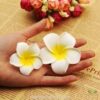**The Importance of Porcelain Flowers in Biodiversity Conservation**

Porcelain flowers, scientifically known as Hoyas, play a crucial role in biodiversity conservation efforts worldwide. As botanical treasures with diverse ecological functions and adaptations, porcelain flowers contribute to the preservation of biodiversity by supporting native flora and fauna, maintaining ecosystem balance, and serving as indicators of environmental health. In this article, we delve into the significance of porcelain flowers in biodiversity conservation and explore how their conservation efforts can safeguard ecosystems for future generations.
**1. Habitat and Ecosystem Support:**
Porcelain flowers are integral components of many ecosystems, where they provide essential habitat and food resources for a variety of organisms. As native plants in tropical and subtropical regions, porcelain flowers serve as hosts for pollinators, including bees, butterflies, moths, and hummingbirds, which rely on their nectar and pollen for sustenance. Additionally, porcelain flowers offer shelter, nesting sites, and food sources for insects, birds, and small mammals, contributing to the overall biodiversity of their habitats.
**2. Pollination Services:**
One of the most critical roles of porcelain flowers in biodiversity conservation is their contribution to pollination services. By attracting and providing rewards to pollinators, porcelain flowers facilitate the transfer of pollen between flowers, enabling the fertilization and reproduction of plants. This process is essential for the production of seeds and fruits, which form the basis of many terrestrial ecosystems and provide food for countless animal species. Without pollination, ecosystems would suffer from reduced plant diversity and diminished ecosystem services.
**3. Indicator Species:**
Porcelain flowers serve as valuable indicator species that reflect the health and integrity of their habitats. As sensitive plants, porcelain flowers respond to changes in environmental conditions, such as habitat loss, pollution, climate change, and invasive species. Monitoring the distribution, abundance, and health of porcelain flower populations can provide valuable insights into broader ecological trends and threats facing ecosystems. By protecting porcelain flowers and their habitats, conservationists can help safeguard biodiversity and ecosystem resilience.
**4. Medicinal and Genetic Resources:**
Porcelain flowers possess valuable medicinal and genetic resources that can benefit both humans and ecosystems. Traditional healers and herbalists have long used parts of porcelain flowers for their medicinal properties, which include anti-inflammatory, antimicrobial, and antioxidant effects. Additionally, porcelain flowers harbor genetic diversity that can be harnessed for plant breeding, restoration, and conservation efforts. By preserving wild populations of porcelain flowers, scientists can maintain genetic reservoirs that may hold the key to future innovations in medicine and agriculture.
**5. Conservation Initiatives:**
Conservation initiatives focused on porcelain flowers are essential for ensuring the long-term survival of these botanical treasures and the ecosystems they inhabit. Efforts to protect porcelain flower habitats, such as national parks, wildlife reserves, and protected areas, provide essential refuges for endangered species and biodiversity hotspots. Additionally, habitat restoration projects aimed at restoring degraded landscapes and reintroducing native flora can help revitalize ecosystems and support porcelain flower populations.
**Conclusion:**
In conclusion, porcelain flowers play a vital role in biodiversity conservation efforts by supporting native flora and fauna, facilitating pollination services, serving as indicator species, and providing valuable medicinal and genetic resources. Conservation initiatives focused on porcelain flowers are essential for preserving biodiversity, maintaining ecosystem balance, and promoting sustainable development. By recognizing the importance of porcelain flowers in biodiversity conservation, we can work together to protect these botanical treasures and the ecosystems they inhabit for future generations to enjoy.

